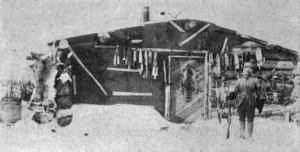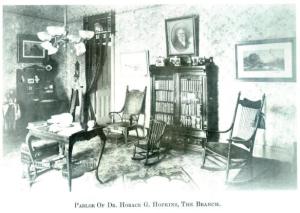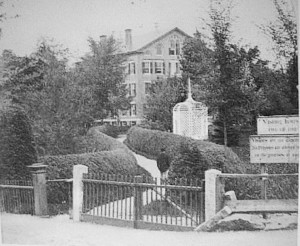Though the city of Canton was small compared to East Coast standards, it was an up and coming community for the far West. Almost as soon as Congress created Dakota Territory, its new territorial legislature began establishing counties. The legislature established Lincoln County (where Canton is located) during its first session in 1862. Continue reading
Category Archives: Canton Asylum for Insane Indians
Local Pride in Canton Asylum
Though insane asylums were not common institutions anywhere, citizens in most locales were delighted to have them situated nearby. Asylums meant jobs, payrolls that workers might spend in town, and an ongoing need for supplies that local merchants could try to meet. Continue reading
The Insane as News Items
Though early alienists did a great deal to de-stigmatize insanity and help families feel better about seeking help for their mentally ill members, insanity was still a delicate subject that most families preferred to keep private. Asylum superintendents understood this. Continue reading
The Chronic Insane
Alienists stressed that the prompt treatment of insanity was imperative to a cure. They cautioned the public that it was far wiser to bring an afflicted person to an asylum for a cure as soon as possible, rather than let the patient languish at home for years until an asylum became a last resort. By that point, the disease might have too strong a hold and never be shaken. Continue reading
Importance of Asylum Gardens
Asylum gardens provided occupational therapy of a sort for patients who were physically able to work in them. Some patients truly enjoyed working in a small flower garden perhaps, or even an hour or two in a vegetable garden.
However, because some superintendents reported having to “force” patients to work outside, this so-called therapy obviously did not appeal to everyone. Continue reading
Searching for Canton Asylum Patients
This is an out-of-schedule post to ask for information about Canton Asylum patients transferred to St. Elizabeths in 1933, for a projected memorial. If you have any information about them, particularly about their lives before they were in Canton Asylum, we would both appreciate it. If you’d like to provide any details, you may simply reply to this post or send information to a private email at: deet84803@mypacks.net.
Joanna, Augusta
Bear, Frank
Charlie (only name)
Charley or Charles, Creeping
Dauphinais, Madeline
Ensign, Meda
Fairbanks, Richard
Jackson, Robert
Kalonuheskie, Edith
Rising Fire, Bessie
Shortwoman, Sarah
Tsinnjinnie, Mabel
Vigil, Fidel
Yazza, Zonna or Sonna
Yazzie, Hoskee
Thank you.
Preserving Food

William We-ah-lup Smoking Salmon, 1906, Tulalip Indian Reservation, courtesy University of Washington Libraries
Patients at the Canton Asylum for Insane Indians, though forced to eat a relatively poor diet of increasingly refined foods provided by the government, benefited from the fresh food and meat raised on the asylum grounds. However, there never seemed to be a sufficiency that allowed the kitchen staff to do much in the way of preserving this more nutritious food for winter use. Continue reading
Food Woes
Choices concerning Bran Flakes and Shredded Krumbles (see last post) weren’t the only food problems patients at the Canton Asylum for Insane Indians suffered. They, like most Native Americans, had already lost a basic underpinning of life–their traditional foods. This loss led to nutritional deficiencies and diseases that had never affected them before encountering the white man’s culture. Continue reading
And More Cereal
Cold, flaked cereals were not a part of traditional Native American diets, but many Native Americans on reservations doubtlessly ate them. So did the patients at the Canton Asylum for Insane Indians.
Both Sylvester Graham and John Harvey Kellogg (see last post) considered grains part of a healthy diet, and created products that reflected their beliefs. Whether or not Superintendent Harry Hummer also believed this or simply had to take what was issued to him through the Indian Office, he did serve this breakfast food at the asylum. Continue reading
Other Dietary Concerns
The American diet has been under attack for nearly two centuries, mainly for its fatty, meat-based content. Like George J. Drews and his unfired or raw food diet (see 10/26/14 post), Sylvester Graham advocated a vegetarian diet. Graham’s diet was not quite as strict, however, since he did allow baked whole grains. However, it was a bland diet that didn’t allow spices–not even pepper. Continue reading







